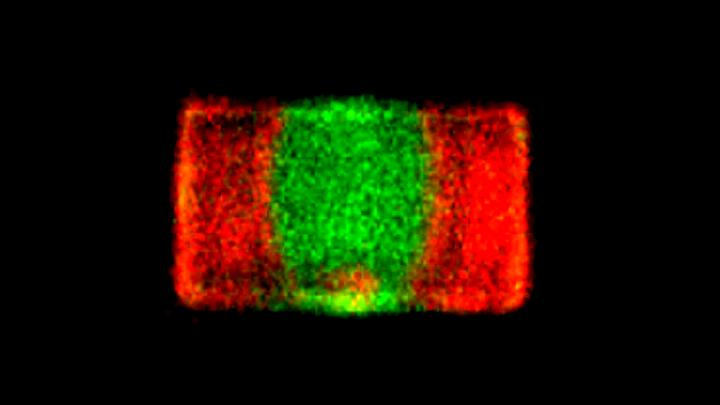Oct 20 2020
Australian scientists have solved a fundamental challenge that has hampered the extensive utilization of next-generation perovskite solar cells.
 Scanning confocal microscope image of a single mixed-halide perovskite crystal showing emission from mixed (green) and segregated (red) regions. The central region is exposed to intense light, which causes the halide-ions in this region to mix, generating green (540–570 nm) fluorescence. The red emission (>660 nm) is from phase-segregated perovskite driven by the low-intensity confocal microscope scanning laser. Image Credit: ARC Centre of Excellence in Exciton Science.
Scanning confocal microscope image of a single mixed-halide perovskite crystal showing emission from mixed (green) and segregated (red) regions. The central region is exposed to intense light, which causes the halide-ions in this region to mix, generating green (540–570 nm) fluorescence. The red emission (>660 nm) is from phase-segregated perovskite driven by the low-intensity confocal microscope scanning laser. Image Credit: ARC Centre of Excellence in Exciton Science.
A kind of hybrid organic-inorganic materials called metal-halide perovskites offer a low-cost, flexible, and high potential means for efficient solar photovoltaics, besides light-emissive devices and fast X-ray detectors.
Although perovskite materials have gained considerable attention over the past 10 years, they have presented engineers and researchers with many issues, which have prevented their extensive use in commercial applications.
One such application is light-induced phase segregation where illumination, for example, sunlight, interrupts the cautiously arranged composition of elements inside the mixed-halide perovskites.
This, on the other hand, results in instability in the bandgap of the material, interfering with the wavelengths of light absorbed and affecting charge-carrier conduction as well as the efficiency of devices.
However, researchers have now found an incredible solution. Members of the ARC Centre of Excellence in Exciton Science have demonstrated that high-intensity light will cancel the interruption caused by light at lower intensities. They also found that this method can be applied to achieve active control of the bandgap of the material.
The findings of the study were published in the Nature Materials journal.
Dr. Chris Hall, a member of Professor Trevor Smith’s team at The University of Melbourne, and Dr. Wenxin Mao from Professor Udo Bach’s group at Monash University initially observed the ability to examine this avenue of investigation at the time of a separate experiment.
It was one of those unusual discoveries that you sometimes hear about in science. We were performing a measurement, looking for something else, and then we came across this process that at the time seemed quite strange. However, we quickly realised it was an important observation.
Dr Chris Hall, University of Melbourne
They sought assistance from Dr. Stefano Bernardi, a member of Dr. Asaph Widmer-Cooper’s group at the University of Sydney, who performed the computational modeling work to gain better insights into their surprising solution to the problem.
What we found is that as you increase the excitation intensity, the local strains in the ionic lattice, which were the original cause of segregation, start to merge together. When this happens, the local deformations that drove segregation disappear.
Dr Stefano Bernardi, University of Sydney
Bernardi added, “On a normal sunny day, the intensity is so low that these deformations are still localised. But if you find a way to increase the excitation above a certain threshold, for example by using a solar concentrator, then segregation disappears.”
The study results could find important applications, with scientists currently capable of retaining the maximum composition of elements inside mixed-halide perovskites upon exposure to light, which is vital for its use in solar cells.
A lot of people have approached this problem by investigating ways of suppressing light-induced disorder, such as looking at different compositions of the material or changing the dimensions of the material.
Dr Chris Hall, University of Melbourne
Chris added, “What we’ve shown is that you can actually use the material in the state that you want to use it, for a solar cell - all you need to do is focus more light onto it.”
“An exciting extension of this work is that the ability to rapidly switch the bandgap with light opens an interesting opportunity to use perovskites in data storage,” stated Wenxin.
“We’ve done the fundamental work and the next step is to put it into a device,” concluded Chris.
Journal Reference:
Mao, W., et al. (2020) Light-induced reversal of ion segregation in mixed-halide perovskites. Nature Materials. doi.org/10.1038/s41563-020-00826-y.